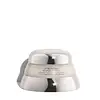What's inside
What's inside
 Key Ingredients
Key Ingredients

 Benefits
Benefits

 Concerns
Concerns

 Ingredients Side-by-side
Ingredients Side-by-side

Water
Skin ConditioningGlycerin
HumectantButylene Glycol
HumectantIsododecane
EmollientIsohexadecane
EmollientDimethicone
EmollientCetyl Ethylhexanoate
EmollientHydrogenated Polydecene
EmollientDisteardimonium Hectorite
StabilisingPEG-9 Polydimethylsiloxyethyl Dimethicone
EmulsifyingPEG-150
HumectantPEG-8 Diisostearate
EmulsifyingPhenoxyethanol
PreservativeMethylparaben
PreservativeEthylparaben
PreservativePhytosteryl Macadamiate
Skin ConditioningSodium Citrate
BufferingParfum
MaskingTrisodium EDTA
Tocopheryl Acetate
AntioxidantStearyl Glycyrrhetinate
Skin ConditioningHydroxyproline
Skin ConditioningCitric Acid
BufferingSodium Metaphosphate
BufferingBenzyl Benzoate
AntimicrobialAlpha-Isomethyl Ionone
PerfumingButylphenyl Methylpropional
PerfumingHexyl Cinnamal
PerfumingLinalool
PerfumingLimonene
PerfumingSodium Acetylated Hyaluronate
HumectantCitronellol
PerfumingGeraniol
PerfumingSaccharomyces Ferment Lysate Filtrate
Skin ConditioningRubus Idaeus Fruit Extract
AstringentCI 77492
Cosmetic ColorantSyzygium Jambos Leaf Extract
Skin ConditioningCI 77491
Cosmetic ColorantTocopherol
AntioxidantWater, Glycerin, Butylene Glycol, Isododecane, Isohexadecane, Dimethicone, Cetyl Ethylhexanoate, Hydrogenated Polydecene, Disteardimonium Hectorite, PEG-9 Polydimethylsiloxyethyl Dimethicone, PEG-150, PEG-8 Diisostearate, Phenoxyethanol, Methylparaben, Ethylparaben, Phytosteryl Macadamiate, Sodium Citrate, Parfum, Trisodium EDTA, Tocopheryl Acetate, Stearyl Glycyrrhetinate, Hydroxyproline, Citric Acid, Sodium Metaphosphate, Benzyl Benzoate, Alpha-Isomethyl Ionone, Butylphenyl Methylpropional, Hexyl Cinnamal, Linalool, Limonene, Sodium Acetylated Hyaluronate, Citronellol, Geraniol, Saccharomyces Ferment Lysate Filtrate, Rubus Idaeus Fruit Extract, CI 77492, Syzygium Jambos Leaf Extract, CI 77491, Tocopherol
 Reviews
Reviews

Ingredients Explained
These ingredients are found in both products.
Ingredients higher up in an ingredient list are typically present in a larger amount.
Phenoxyethanol is a preservative that has germicide, antimicrobial, and aromatic properties. Studies show that phenoxyethanol can prevent microbial growth. By itself, it has a scent that is similar to that of a rose.
It's often used in formulations along with Caprylyl Glycol to preserve the shelf life of products.
Tocopherol (also known as Vitamin E) is a common antioxidant used to help protect the skin from free-radicals and strengthen the skin barrier. It's also fat soluble - this means our skin is great at absorbing it.
Vitamin E also helps keep your natural skin lipids healthy. Your lipid skin barrier naturally consists of lipids, ceramides, and fatty acids. Vitamin E offers extra protection for your skin’s lipid barrier, keeping your skin healthy and nourished.
Another benefit is a bit of UV protection. Vitamin E helps reduce the damage caused by UVB rays. (It should not replace your sunscreen). Combining it with Vitamin C can decrease sunburned cells and hyperpigmentation after UV exposure.
You might have noticed Vitamin E + C often paired together. This is because it is great at stabilizing Vitamin C. Using the two together helps increase the effectiveness of both ingredients.
There are often claims that Vitamin E can reduce/prevent scarring, but these claims haven't been confirmed by scientific research.
Learn more about TocopherolWater. It's the most common cosmetic ingredient of all. You'll usually see it at the top of ingredient lists, meaning that it makes up the largest part of the product.
So why is it so popular? Water most often acts as a solvent - this means that it helps dissolve other ingredients into the formulation.
You'll also recognize water as that liquid we all need to stay alive. If you see this, drink a glass of water. Stay hydrated!
Learn more about Water